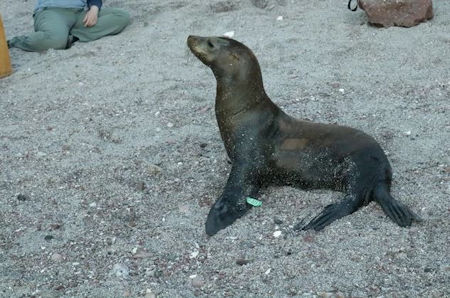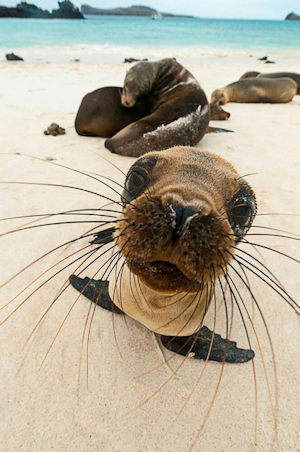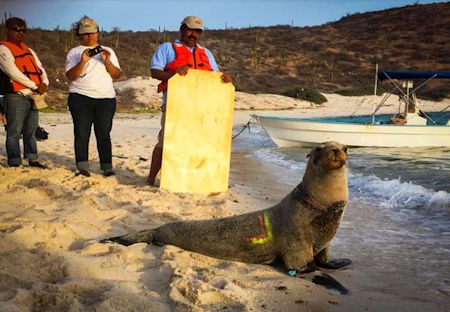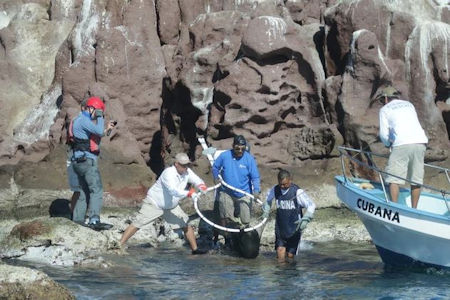 |  |

The California Sea Lion
The California sea lion (Zalophus californianus) is one of six species of sea lion from the family Otariidae (eared seals). They range from south-east Alaska to the southernmost tip of the Baja California peninsula and the Galapagos Islands.
Although the California sea lion isn’t considered to be under threat from extinction (International Union for the Conservation of Nature (IUCN, 2014)), individuals, groups and colonies can be negatively impacted by human activities including uncontrolled/irresponsible tourism, shipping, coastal development, culling, pollution and fishing.
The city of La Paz and visitors drawn to its marine delights absolutely adores its sea lions and thankfully the species has been subject to special protection under Mexican law since 1994 allowing them to thrive in their naturally chosen habitats.
The largest colony of sea lions around La Paz can be found at Los Islotes, a pair of rocky islets at the northern-most point of the land component of the Espiritu Santo National Park. Here the population fluctuates between around 400-500 individuals, the hustle and bustle within the colony being somewhat reminiscent of that of a vibrant town.

Los Islotes is one of three no-take zones that form the nucleus of marine protection within the island group. Enforcing this protection is “La Comisión Nacional de Áreas Naturales Protegidas” (CONANP) who direct the management of natural protected areas in Mexico. Their patrol boats can often be seen in the Espiritu Santo National Park checking the permits and compliance of tour boats and keeping their eyes on the water for illegal fishing activity.
Despite this protection, the no-take zones often show traces of illegal sport fishing and commercial fishing activities evident by the presence of ghost fishing gear, that is, lost or discarded fishing gear in the ocean that has the potential of unintentionally trapping and/or injuring or killing marine animals. Ghost fishing gear includes nets, ropes, fishing lines, hooks and fish traps. This long-forgotten apparatus is an indiscriminate killer of marine life. Victims include fish, sharks, turtles, dolphins, whales, mantas, mobula rays and, as you can probably guess, sea lions.
In the case of sea lions, individuals, particularly inquisitive juveniles that are starting to explore their environment, can become entangled in ghost fishing gear which can lead to their immediate death if they are unable to free themselves in time to return to the surface. The more they struggle for freedom, the more entangled they are likely to become. A drowned sea lion hanging motionless in a gill net is a distressing sight to see with one’s own eyes.
There are times when sea lions become entangled in smaller remnants of nets, ropes or line that form a noose around their necks. This condition is particularly dangerous and painful for individuals that still have some growing to do. While initially the entanglement may be nothing more than an annoyance to the animal, as they continue through their growth, their unwanted “necklace” of marine debris can become tighter until the point where it cuts into the flesh and even the bone obviously causing much pain and discomfort. If untreated, such victims may suffer miserably before finally succumbing to their unfortunate condition.
But there’s good news for the California sea lions of Los Islotes and other areas in Mexico. An ongoing project has been hard at work for the last five years to rescue individuals that are found to be in urgent need of assistance. This project is aptly named “Rescate de Lobos Marinos”, translating to “Rescue of Sea Wolves”, their name in the Spanish language.

The story of this project begins in the year 2014 when a La Paz local distressed by the condition of some of the sea lions at Los Islotes started the process to form an alliance that would come to the aid of specimens in need of medical attention. Originating from Mexico City, documentary filmmaker and Ph.D candidate, Eréndira Valle, has lived in La Paz for the last 14 years. While interviewing a sea lion expert during the production of a short documentary, Eréndira became aware of the scale of the impact of marine debris on the the population of Los Islotes and since then has not stopped working towards the solution. Five years down the line it is fantastic to see how the project has since grown and it’s all down to the unwavering passion of the team together with the support of the community here in La Paz.
About Rescate de Lobos Marinos.
Rescate de Lobos Marinos is an interdisciplinary group working in biological and social fields that includes Mexican authorities such as CONANP, SCT (communications and transport secretary) and SEMAR (marine secretary), as well as the civil society and tourism service providers. They conduct monitoring and surveillance of the sea lion populations in the Espiritu Santo National Park and other protected areas on the Baja peninsula and in the Gulf of California. Their mission includes alleviating the negative impacts of ghost fishing gear and marine debris on the health and welfare of affected sea lions.
In 2015, team member and veterinary surgeon Daniela Bárcenas contacted The Marine Mammal Centre in California (TMMC) to request their collaboration to come to La Paz and update the environmental authorities on the latest capture and rescue techniques. Thanks to the many individuals, groups and service providers that gave their support, workshops were conducted later that year to train the corresponding entities on these techniques.

Sedative medications are administered using a dart fired from a modified rifle. An acoustic transmitter is attached to the dart so the animal’s location can be quickly determined. This methodology facilitates the safe use of sedative drugs on sea lions in the marine environment.
Once captured, the individual is transferred to an in-situ work station where the marine debris is removed and the wounds treated as necessary. Each rescue is given a general health check and measurements and samples are taken that may later be used for scientific research. Treated individuals are fitted with an ID tag so that their recovery can be easily monitored. Once all treatment is complete the animal can quickly recover and return to the sea. For smaller or weak individuals for whom the sedative medication may pose too much of a risk, the preferred method of capture is by using ring nets.
Since becoming operational, Rescate de Lobos Marinos has successfully captured and rescued 25 California sea lions in their area of work. They continue to monitor the various colonies, keeping a close eye out for individuals in need.
The project is continually working towards providing a national network of teams with the required training with the aim of each becoming self-sufficient in the capture and rescue of sea lions in their area. As well as La Paz, the project has reached out to Cabo Pulmo, Cabo San Lucas and Margarita Island in Baja California Sur, Bahía de Los Ángeles and Ensenada in Baja California and Puerto Peñasco in Sonora.
What can you do to help?
You can support the work of Rescate de Lobos Marinos in several ways.

The California sea lions in and around La Paz are great attraction for locals and visitors alike and they generate substantial economic and social benefits for the city.
I urge you to please consider supporting their rescue using one or more of the methods listed above. By doing so, you will be making a real difference to the welfare of the sea lions of La Paz and beyond. The next rescue expedition is coming very soon.
For more information about Rescate de Lobos Marinos you can visit their website or email contacto(at)rescatedelobosmarinos.org.

Use this Insurance Every Time I go to Baja .If you call them they have good service or you can get...

Honestly their app is so fantastic and saves all my info I can literally buy the same insurance for...

Very excellent service, needed insurance for Mexico, price was fair. The custumer service rep was...